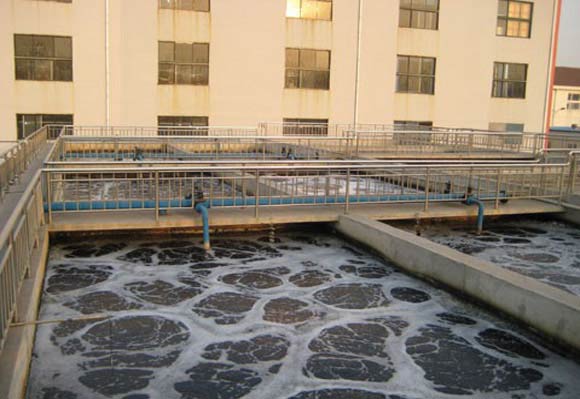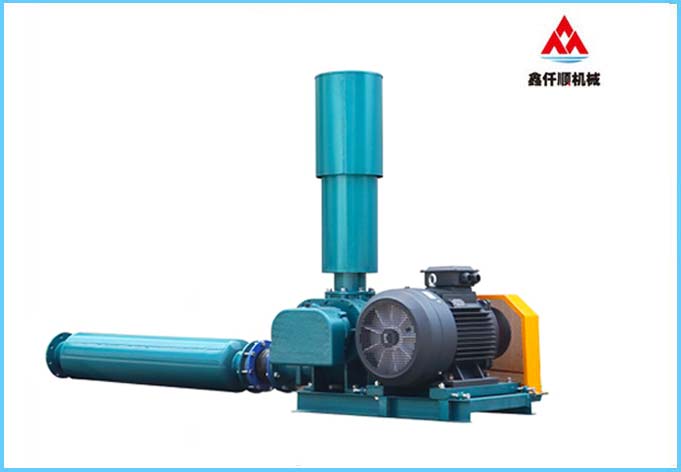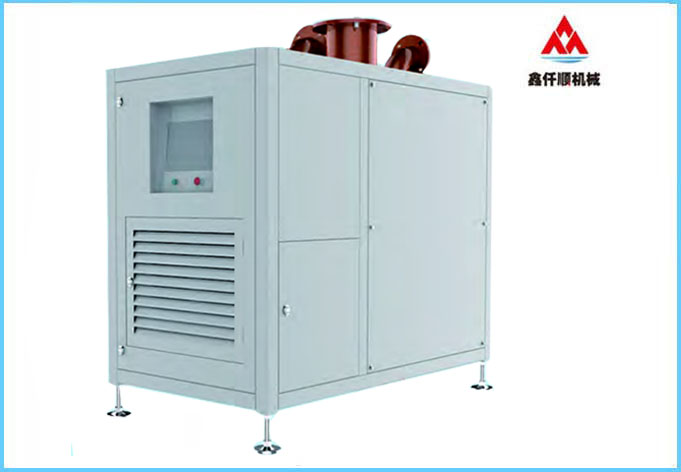Sewage Treatment Cases of Roots Blower Treating Titanium Dioxide:
In November 2021, Manager Wang of Xi'an purchased a batch of Roots blowers, including four sr125 blowers, one of which is for standby. We will explain how to treat the wastewater generated by titanium dioxide with Roots blowers from the process.
The enterprise uses sulfuric acid method to produce titanium dioxide products. There are a lot of acid substances in industrial wastewater (about 2000 m3/h), as well as suspended solids, ferrous and waste acid.
The original industrial sewage and wastewater treatment method: neutralization aeration sedimentation method. The treatment effect is generally not very good, and there will be problems: if the lime milk is continuously used for neutralization, a lot of yellowstone paste will be produced, and the economic value of yellowstone paste is very low. Subsequent utilization and disposal are difficult.
To solve this problem, we choose a new wastewater treatment method:
Roots blower is used for aeration, with high oxygen utilization rate, increased aeration volume, energy saving, low treatment cost, large oxidation aeration density and small aeration tank area, in order to achieve win-win economic benefits. The enterprise adopts the process of neutralization, aeration, oxidation and precipitation of two-stage roots blower.
The roots blower is used to aerate at the bottom of the aeration tank, and the limestone neutralization method is used to treat the acidic wastewater generated from the production of titanium dioxide by the sulfuric acid method, which can effectively remove sulfate ions and heavy metal ions in the water, and adjust the pH value of the water. The equipment investment requirement is small, the treatment process is simple and easy, the system maintenance is convenient, the treated water volume is large, and the treatment process is relatively mature. However, the current process still has many shortcomings: first, the problem of waste residue treatment. During the treatment process, a large amount of CaSO4 precipitation is generated, which forms a hard scale on the surface of the structure, seriously reducing the treatment effect of wastewater. Moreover, this precipitation is a secondary pollution to the environment, and its utilization value is not high.

1 Wastewater quality
The production process of titanium dioxide produced by sulfuric acid process is mainly composed of grinding, acidolysis, reduction, freeze crystallization, hydrolysis, filtration, water washing, calcination, crushing, etc. of ilmenite. In this process, hydrolysis, water washing and acidolysis sections produce a large amount of acidic wastewater, which contains a large amount of Fe2+, Fe3+, SO42 -, H+and a small amount of Ti3+, Ca2+
Mg2+, Cr2+, pH value is generally 1~3, chroma is 800~1000 times, which causes great environmental pollution. The hydrolysis mother liquor (high concentration acid wastewater, also called waste acid) contains 15%~20% sulfuric acid, 5% FeSO4, 42% TiOSO4, and 32% Al2 (SO4); Water washing wastewater (medium concentration acid wastewater) mainly comes from metatitanic acid water washing section, containing 0.8%~1.0% H2SO4, 0.1% FeSO4 and a small amount of other soluble sulfate; The acid hydrolysis tail gas alkali washing wastewater (medium concentration acid wastewater) is produced by washing the acid mist in the acid hydrolysis tail gas with dilute alkaline solution. The washing waste liquid is recycled after cooling down, and discharged after recycling to a certain extent, but the emission is relatively small, containing 41.5% FeSO4 and 4.3% H2SO4.
2 Acid wastewater treatment process
The original process adopts ordinary neutralization and precipitation method, which has high pH control, Fe2+is not easy to precipitate, and the effluent is difficult to reach the standard. Neutralization, aeration and sedimentation methods are adopted after transformation, and the process flow is shown in Figure 1.
2.1 Determination of neutralizer
Lime is widely sourced and cheap, which can neutralize acidic wastewater of different concentrations, and Ca (OH) 2 itself has a coagulation effect on impurities in the wastewater. Therefore, lime is used as neutralizer in the treatment of acid wastewater from titanium dioxide. The quicklime is digested by the ash eliminator to prepare a solution of 5% ~ 10% Ca (OH) 2.
2.2 Neutralization reaction and settlement
The main pollutants in the acid wastewater of titanium dioxide are H2SO4 and FeSO4, which react with Ca (OH) 2 emulsion to generate CaSO4 precipitation and Fe (OH) 2. In actual production, try to oxidize Fe (OH) 2 into Fe (OH) 3 by aeration to remove Fe (OH) 3, mainly because the solubility product of Fe3+is lower than that of Fe2+; 3.2.2 The residual Fe (OH) 2 in wastewater can react with potassium dichromate to increase the COD content in wastewater; The slow oxidation of the residual Fe (OH) 2 in the wastewater will gradually reduce the pH value of the effluent, which may lead to the effluent quality exceeding the standard in serious cases;
The concentration and dehydration of Fe (OH) 2 sediment is more difficult than that of Fe (OH) 3 sediment. When pH value is 5.5, the solubility of Fe (OH) 3 is the smallest; When the pH value is 7~7.5, Fe2+can be rapidly converted into Fe3+.
Therefore, in the actual operation process, the dosing of Ca (OH) 2 emulsion should be regulated through the pH online control valve to control the neutralized pH value between 5.5 and 7.5, so as to transform Fe2+into Fe3+as much as possible. If the pH value is too high, Fe2+will be precipitated when it is obtained and converted into Fe3+in the future, resulting in difficult post-treatment. Generally speaking, the content of iron ion in the acid wastewater of titanium dioxide is relatively high. When the removal effect of iron ion in the wastewater reaches the national discharge standard, the content of other heavy metal ions can also meet the requirements.
2.3 Influence of aeration effect on effluent quality
Whether Fe2+can be fully oxidized to Fe3+, in addition to the need for proper pH value, there should be sufficient dissolved oxygen in the wastewater. When the dissolved oxygen is insufficient, the product produced in the treatment process is mainly Fe (OH) 2, which is not easy to precipitate and unstable, and is gradually oxidized in the discharge process, resulting in the pH value of the effluent gradually reducing, or even exceeding the discharge standard. At the same time, because Fe (OH) 2 can be oxidized, the COD of wastewater will be increased, which may exceed the standard in serious cases. Therefore, the aeration effect directly affects the treatment effect.

2.4 Selection of sedimentation tank
Due to the high viscosity of CaSO4, the use of inclined plate and inclined tube sedimentation tank is easy to cause blockage, and the maintenance workload is large; The vertical flow sedimentation tank is suitable for small flow, and is difficult to construct, high in cost, and poor in adaptability to impact load; The sludge discharge equipment of radial flow sedimentation tank is complex, which requires high construction quality and high cost; The quality and flow of waste water vary greatly, so it is suitable to use horizontal flow sedimentation tank, which has good sedimentation effect, strong adaptability to impact load, simple construction and low cost. The actual operation results show that the sedimentation effect is good and the effluent is relatively stable.
2.5 Sludge treatment
The water content of the sludge discharged from the sedimentation tank is high. Generally, the sludge is concentrated in the sludge thickening tank to reduce the water content of the sludge as much as possible before mechanical dewatering, which is conducive to improving the production capacity of the dewatering equipment; At the same time, the sludge thickener also plays the role of sludge storage and buffer. Titanium dioxide acid wastewater sludge is inorganic sludge, and its main component is CaSO4. Belt filter press and centrifugal dehydrator are used for dewatering. Although they can operate continuously, the moisture content of filter cake is high (75%~85%), the transportation of mud cake is difficult, and the cost is high. In addition, flocculants need to be added before dewatering. The quality of flocculation effect directly affects the dewatering effect, and flocculants are expensive.
3 Conclusion
Roots blower for sewage treatment The process design of oxidation tank with high aeration intensity and oxygen utilization rate can reduce the project investment, floor area and aeration energy consumption of oxidation tank. Anti clogging silica gel aeration pipe can effectively solve the problem of scaling and blocking of microporous aeration pipe through regular high-pressure and chemical cleaning of the aeration pipe. The cleaning cycle is determined according to the change of air pressure and air volume, which is about 2-3 months.
The production process should be continuously improved to eliminate pollution from the source. We should accelerate the establishment and improvement of the technological innovation system, constantly strengthen the technological development force, increase the investment in technological development funds, and accelerate the development of technologies and leading products with independent intellectual property rights; It is necessary to actively explore the mode of technological innovation, carry out various forms of combination of production, teaching and research, attract scientific research forces from scientific research institutions and colleges and universities, jointly tackle key technical problems in titanium dioxide production, and promote the transformation of scientific and technological achievements into real productive forces. Increasing the production scale of chlorination process is an effective way to improve the quality of titanium dioxide in China.










